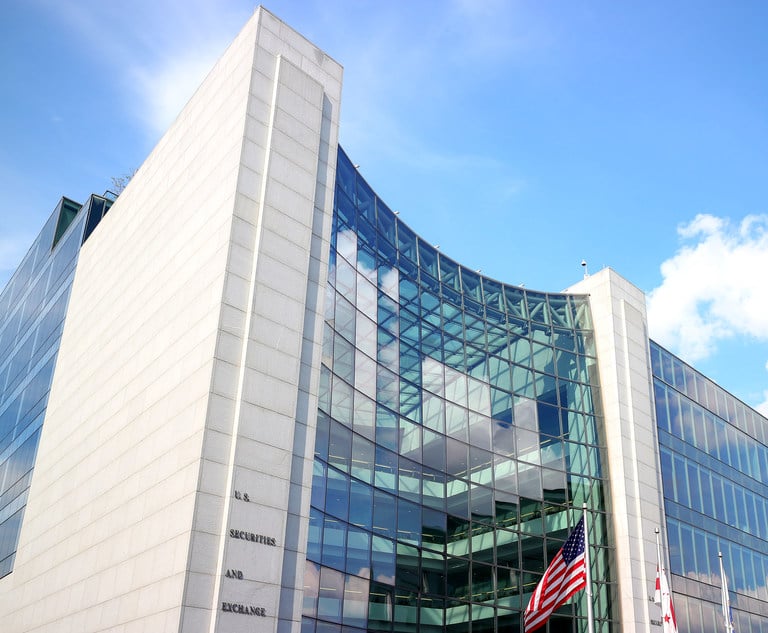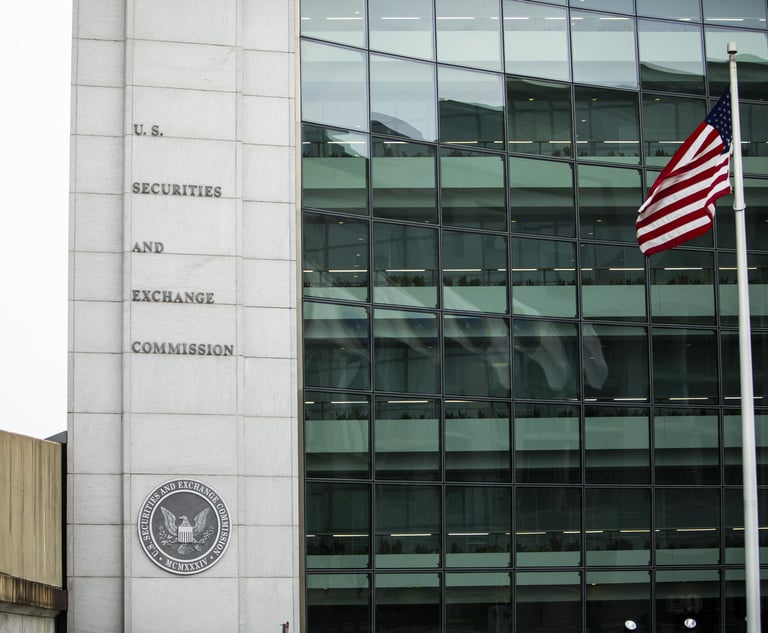Compliance Pros in Survey Predict Doom and Gloom Around Anti-Corruption Risks This Year
“The stakes are high and so is the risk level, which is likely causing some sleepless nights for the average compliance professional,” said one expert.
March 15, 2018 at 01:09 PM
4 minute read
 Credit: Shutterstock.com
Credit: Shutterstock.com
Compliance with anti-bribery and corruption rules has long been a challenge for legal departments, and according to a new survey, the risks are going to continue—or get even worse—in 2018.
The eighth annual Anti-Bribery and Corruption Benchmarking Report, released this week by Kroll and the Ethisphere Institute, surveyed nearly 450 senior-level executives across the globe working in compliance, and found that 93 percent expect anti-bribery and corruption risk to either remain the same or become increasingly difficult this year.
“The stakes are high and so is the risk level, which is likely causing some sleepless nights for the average compliance professional,” said Steven Bock, who is global head of operations for risk solutions company Kroll's compliance practice, in the announcement of the report's release Wednesday. “In today's hypersensitive business environment where a company's hard-earned reputation can be easily lost through a lapse of judgment by a third party, the job of a conscientious compliance professional has never been tougher or more central to the success or failure of a business.”
The top source of angst for the compliance professionals surveyed was indeed third parties and their potential to introduce bribery and corruption. Some 58 percent of respondents said they found legal, ethics or compliance issues with a third party after performing due diligence.
More often than not, according to the survey, the company's due diligence manages to catch a problem, instead of the third party disclosing it. But on the bright side, there was also a growing amount of self-disclosure of issues from third parties, a trend the report called “a clear reflection of changing cultural and regulatory trends, including heightened concern over personal liability.”
The sheer number of third parties that companies engage with may be making matters more complicated—45 percent of those participating in the survey said their businesses worked with 1,001 or more third parties, up from 40 percent in last year's edition of the survey. The survey defined third party as “any person or entity you partner with in order to do business” not including customers.
The second most cited risk to the respondents' anti-bribery and corruption programs was the complex global regulatory landscape—a concern that the report indicated is on the rise amongst compliance professionals. The report pointed to China's corruption crackdown, the implementation of the General Data Protection Regulation and the Foreign Corrupt Practices Act Pilot Program as examples of how rules and frameworks are changing at a fast clip.
Here are some of the other notable findings from the 27-page report:
- Some 30 percent of respondents said they monitored all their third parties, while 45 percent only monitored the high risk ones. The other 25 percent had no third-party monitoring.
- For the second year in a row, the two top reasons that potential third parties failed to meet respondents' ethics and compliance standards were “general reputational or integrity concerns” and “conflicts of interest,” in that order. What has changed is the rise of “opaque or suspect reporting structures” to No. 3 in the rankings, a jump from No. 5 in 2017.
- Respondents often collected less information about M&A targets' third parties than they collected about their own third parties. For instance, 86 percent of respondents collected ownership information about their own third parties, but only 34 percent got this data on their targets' third parties.
- Fear of personal liability for compliance failure is an issue for many respondents. Compared to 2017, 22 percent were more concerned about being held personally responsible in 2018. For about 65 percent of the respondents, the level of concern about this stayed the same year over year.
This content has been archived. It is available through our partners, LexisNexis® and Bloomberg Law.
To view this content, please continue to their sites.
Not a Lexis Subscriber?
Subscribe Now
Not a Bloomberg Law Subscriber?
Subscribe Now
NOT FOR REPRINT
© 2025 ALM Global, LLC, All Rights Reserved. Request academic re-use from www.copyright.com. All other uses, submit a request to [email protected]. For more information visit Asset & Logo Licensing.
You Might Like
View All
Starbucks Hands New CLO Hefty Raise, Says He Fosters 'Environment of Courage and Joy'
Trending Stories
- 1Starbucks Sues Ex-Executive to Recover $1M Signing Bonus
- 2Navigating AI Risks: Best Practices for Compliance and Security
- 320 New Judges? Connecticut Could Get Wave of Jurists
- 4Orrick Loses 10-Lawyer Team to Herbert Smith in Germany
- 5‘The US Market Is Critical’: KPMG’s Former Head of Global Legal Services On the Legal Arm of the Big Four Firm Entering the US
Who Got The Work
J. Brugh Lower of Gibbons has entered an appearance for industrial equipment supplier Devco Corporation in a pending trademark infringement lawsuit. The suit, accusing the defendant of selling knock-off Graco products, was filed Dec. 18 in New Jersey District Court by Rivkin Radler on behalf of Graco Inc. and Graco Minnesota. The case, assigned to U.S. District Judge Zahid N. Quraishi, is 3:24-cv-11294, Graco Inc. et al v. Devco Corporation.
Who Got The Work
Rebecca Maller-Stein and Kent A. Yalowitz of Arnold & Porter Kaye Scholer have entered their appearances for Hanaco Venture Capital and its executives, Lior Prosor and David Frankel, in a pending securities lawsuit. The action, filed on Dec. 24 in New York Southern District Court by Zell, Aron & Co. on behalf of Goldeneye Advisors, accuses the defendants of negligently and fraudulently managing the plaintiff's $1 million investment. The case, assigned to U.S. District Judge Vernon S. Broderick, is 1:24-cv-09918, Goldeneye Advisors, LLC v. Hanaco Venture Capital, Ltd. et al.
Who Got The Work
Attorneys from A&O Shearman has stepped in as defense counsel for Toronto-Dominion Bank and other defendants in a pending securities class action. The suit, filed Dec. 11 in New York Southern District Court by Bleichmar Fonti & Auld, accuses the defendants of concealing the bank's 'pervasive' deficiencies in regards to its compliance with the Bank Secrecy Act and the quality of its anti-money laundering controls. The case, assigned to U.S. District Judge Arun Subramanian, is 1:24-cv-09445, Gonzalez v. The Toronto-Dominion Bank et al.
Who Got The Work
Crown Castle International, a Pennsylvania company providing shared communications infrastructure, has turned to Luke D. Wolf of Gordon Rees Scully Mansukhani to fend off a pending breach-of-contract lawsuit. The court action, filed Nov. 25 in Michigan Eastern District Court by Hooper Hathaway PC on behalf of The Town Residences LLC, accuses Crown Castle of failing to transfer approximately $30,000 in utility payments from T-Mobile in breach of a roof-top lease and assignment agreement. The case, assigned to U.S. District Judge Susan K. Declercq, is 2:24-cv-13131, The Town Residences LLC v. T-Mobile US, Inc. et al.
Who Got The Work
Wilfred P. Coronato and Daniel M. Schwartz of McCarter & English have stepped in as defense counsel to Electrolux Home Products Inc. in a pending product liability lawsuit. The court action, filed Nov. 26 in New York Eastern District Court by Poulos Lopiccolo PC and Nagel Rice LLP on behalf of David Stern, alleges that the defendant's refrigerators’ drawers and shelving repeatedly break and fall apart within months after purchase. The case, assigned to U.S. District Judge Joan M. Azrack, is 2:24-cv-08204, Stern v. Electrolux Home Products, Inc.
Featured Firms
Law Offices of Gary Martin Hays & Associates, P.C.
(470) 294-1674
Law Offices of Mark E. Salomone
(857) 444-6468
Smith & Hassler
(713) 739-1250









